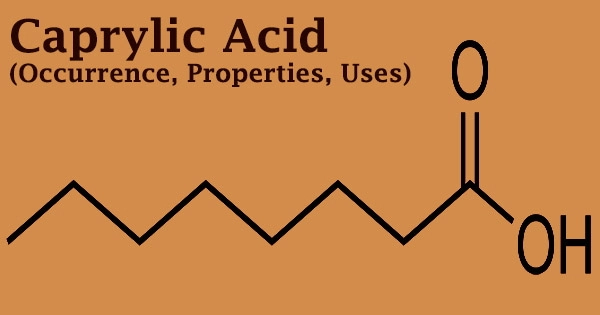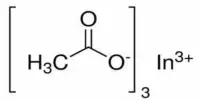Caprylic acid, commonly known as octanoic acid, is a saturated medium-chain fatty acid having an 8-carbon backbone. It gets its name from the Latin word capra, which means “goat.” It has a colorless to light yellow appearance and a slight odor. Corrosive to metals and tissue; burns but may be difficult to ignite. It has the molecular formula CH3(CH2)6CO2H and is a saturated fatty acid and carboxylic acid.
Caprylic acid is a type of healthy saturated medium-chain fatty acid that has antibacterial, antiviral, antifungal, and anti-inflammatory activities. Its components can be found in breast milk, coconut oil, and palm kernel oil. It’s a colorless, greasy liquid that’s very marginally soluble in water and has a rancid-like odor and flavor. Octanoates or caprylates are the salts and esters of octanoic acid.
It’s a straight-chain saturated fatty acid that’s heptane with a carboxy group replacing one of the hydrogens in a terminal methyl group. It is a common industrial chemical made from the oxidation of C8 aldehyde. Its components can be found in the milk of a variety of mammals and as a minor component of coconut and palm kernel oils.
It’s an oily liquid with a slightly rancid-like odor and flavor that’s just marginally water soluble. It is widely used in a variety of fields, including as an antimicrobial pesticide in commercial food handling establishments on dairy equipment, food processing equipment, breweries, wineries, and beverage processing plants, and as a food contact surface sanitizer in commercial food handling establishments on dairy equipment, food processing equipment, breweries, wineries, and beverage processing plants.

This substance belongs to the medium-chain fatty acid family of chemical substances. Fatty acids having an aliphatic tail of 4 to 12 carbon atoms are known as aliphatic fatty acids. It’s an oily liquid with a slightly rancid-like scent and flavor that’s hardly soluble in water.
Caproic (C6) and capric (C10) are two additional acids named after goats. These, along with caprylic acid, account for 15% of goat milk fat. Octanoic acid, commonly known as caprylic acid, is an antibacterial agent, a human metabolite, and a metabolite produced by Escherichia coli. Beer, brandy distillate, the essential oil of fermented Russian black tea leaves, and raw soybeans have all been shown to contain it in trace concentrations.
It’s been found in the essential oils of Cupressus torulosa, Cryptomeria japonica, Andropogon iwarancusa, Cymbopogon javanensis, camphor, nutmeg, lemongrass, lime, tobacco (flowers), Artemisia herba-alba, chamomile, hops, and others; it’s also been found in apple aroma, coconut oil as a glyceride, and wine as an ester; it has been identified (free and esterified) among the constituents of petitgrain lemon oil.
Also reported in many foods and beverages including apple, banana, lemon and grapefruit peel oils, cranberries, guava, grapes, raisin, strawberry, raspberry, pineapple, burley, cheddar cheese, cooked lamb and mutton, papaya, potato, tomato, bell pepper, sauerkraut, ginger, peppermint and spearmint oil, breads, many cheeses, butter, milk, yogurt, cooked egg, fish, meats, hop oil, beer, rum, cider, whiskies, grape wines, cocoa, coffee, tea, peanut oil, pecans, oats, coconut products, passion fruit, blue cheese, beans, sweet marjoram, mushroom, cardamom, coriander seed, sesame seed, mango, tamarind, fig, calamus, rice, radish, dill, corn oil, loquat, licorice, sake, buckwheat, malt, wort, elderberry, cherimoya, kiwifruit, shrimp, clam, scallop and Chinese quince.
Caprylic acid has been used to treat children with intractable epilepsy as part of a ketogenic diet. It’s being studied as a therapy for essential tremor right now. It is classified as a short or medium chain fatty acid since it has an eight-carbon chain. It’s a colorless, oily liquid with a scorching, rotten taste and a moderately unpleasant odor. Water dissolves it just slightly (68 mg per 100 mL at 20°C).
It is a conjugate acid of an octanoate and is a straight-chain saturated fatty acid and a medium-chain fatty acid. It’s found in coconut and palm nut oils, as well as butter fat. Beer, brandy distillate, the essential oil of fermented Russian black tea leaves, and raw soybeans have all been shown to contain trace levels of caprylic acid.
Caprylic acid is utilized in the commercial synthesis of esters, which are employed in perfumery, as well as the production of colors. It is made from the volatile fatty acids found in coconut oil through fermentation and fractional distillation. Caprylic acid is an antimicrobial pesticide used as a food contact surface sanitizer on dairy equipment, food processing equipment, breweries, wineries, and beverage processing plants in commercial food handling enterprises.
It is used in baked goods at a maximum level of 0.13 percent, 0.04 percent for cheeses, 0.005 percent for fats and oils, frozen dairy desserts, gelatins and puddings, meat products, and soft sweets, 0.016 percent for snack foods, and 0.001 percent or less in all other food categories. It’s also known as octanoic acid. Health-care facilities, schools/colleges, animal care/veterinary facilities, industrial facilities, office buildings, recreational facilities, retail and wholesale companies, livestock premises, restaurants, and hotels/motels all utilize it as a disinfectant.
Caprylic acid is also utilized as an algaecide, bactericide, and fungicide on ornamentals in nurseries, greenhouses, garden centers, and interiorscapes. It’s products are available as soluble concentrates/liquids and ready-to-use liquids. Caprylic acid aids in the regulation of energy intake and output in the body, a function that is carried out by the hormone ghrelin.
Information Sources:















